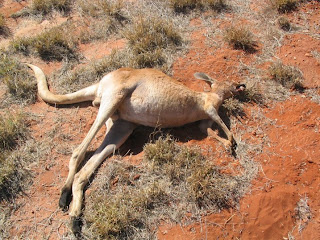In the beginning when the text says ”The boy swallowed. He cleared his throat. He swallowed again. He braced his legs wide and snuggled the rifle to his eye” (p. 26, l. 18-19) the boy seems to be very emotional and nervous at this time. He does not feel safe about the fact that he is going to shoot and kill the kangaroos. “The boy was disappointed. He had expected more, but didn’t know what. He had thought that somehow this would make him a man - but it had made no difference at all” (p. 26, l. 37-39). When the boy finally kills the kangaroos he had expected a much more manly feeling because the man kept telling him that shooting and killing the kangaroos would make him a man. But the boy felt nothing. He was empty inside. “Suddenly the boy felt very calm. His eyes saw his hands lift the rifle. He felt nothing. He felt as if he were dead. The sights, blurred by his tears, danced about the man’s head. They steadied a moment. ‘Dead,’ said the boy” (p. 29, l. 18-21). At the end it seems like the boy regrets that he had kill the kangaroos for no reason. He had expected that he would become a man, but he didn't. We think that he kills the man because throughout the hunt he might have developed a lot of hate against the man, because the man always correct him and tells him what to do, it could be a way of showing that the man is not in charge of the boy. We can see that the boy develops from being emotional and nervous to being a coldblooded killer.
This picture shows how he end to be in the story. It shows that he goes from being a insecure boy to a coldblooded killer. The picture is also black, and that also symbolize his coldness, and with no color.
We took this picture because "insecurity" describes his personality in the start of the text.
Every member of the group was attending to this lesson : Camilla, Kathrine, Kirstine, Christian









